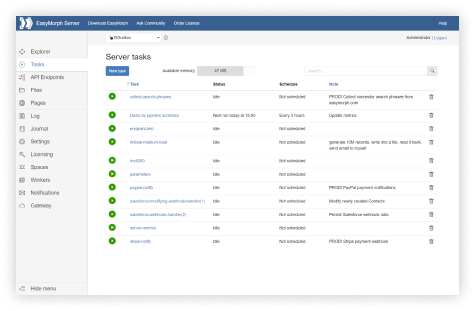Multi-purpose data automation platform powered by visual workflows. A jack of all trades for your data.
- Easy installation & administration
- Flat price, unlimited users, unlimited usage
- Runs on a cloud VM or on-premises
Multi-purpose data automation platform powered by visual workflows. A jack of all trades for your data.


A surprisingly powerful, easy-to-use data transformation (ETL) server that doesn't stand in your way.
Run on demand or schedule hundreds and thousands of complex workflows that perform extracting, transforming, and loading data from and into databases, enterprise applications, web APIs, and files using more than 180 built-in actions (transformations) and 50+ enterprise integrations.


Deploy internal web (REST) APIs faster and easier using visual workflows instead of coding. Create APIs for real-time automation and data exchange between databases, internal applications, cloud applications, and legacy systems.


A highly customizable built-in issue tracker for team collaboration and business process automation.
Manage data quality issues, process incoming orders, get alerts about suspicious transactions or system incidents, and build approval workflows without coding.


Consolidate, link, and explore in one web portal all data from your business applications and databases. Retrieve and download datasets and files with a single click regardless of their location.
EasyMorph Explorer is a data virtualization technology for business users that helps avoid costly Business Intelligence and Data Warehousing technologies.

To manage multiple departments and teams, EasyMorph Server offers spaces — isolated user workgroups with own workflows, files, and data connectors.
Browse, upload, and download files required for ETL tasks or generated by workflows, right from a web-browser. Access remote locations such as SFTP, S3, or Azure Blob Storage.
EasyMorph Server can be connected to EasyMorph Gateway, a cloud service for integration with external and cloud application via real-time webhooks.
Schedule Server tasks to run once, hourly, continuously, daily, weekly, or monthly.
Email notifications about failed workflows and server configuration warnings.
EasyMorph always processes data locally. No data or telemetry sent to the cloud. Optional dataset encryption helps secure data at rest.
Use Active Directory for user authentication.
Isolated Windows processes that run tasks and spaces operations under separate Windows accounts for better security.
Assign and manage EasyMorph Desktop licenses right from EasyMorph Server.
EasyMorph automatically generates a human-readable description of each workflow in plain English
See example
The Server journal records workflow runs as well as user actions for audit and governance.
Open-source cross-platform tools for programmatic integration with EasyMorph Server from scripts and applications.
Unlike cloud-based tools that require you to send your data to someone's server somewhere in exchange for the banal promise that "your privacy is our top priority", with EasyMorph your data simply never leaves your computer(s). It stays where it is, where you can control it.
| Features\Edition | Basic Server | Starter Server | Team Server | Enterprise Server |
|---|---|---|---|---|
| Unlimited users that run Server workflows | ||||
|
Users spaces
Spaces are isolated workgroups for teams. Each space has its own workflows, connectors, files, user roles, etc. Typically, in an organization, every department has its own space. |
1 | 1 | Unlimited | Unlimited |
|
Explorer
The Explorer allows users to find, explore, filter, and download pre-computed and dynamically computed datasets, track metrics, navigate to various data assets, as well as automate teamwork and business processes using the built-in issue tracker. |
||||
| Enterprise authentication (AD, Entra) | ||||
|
Max server RAM, GB
Maximum permitted memory (RAM) available to Windows on the machine that runs EasyMorph Server. If the machine has more RAM than permitted by the edition, EasyMorph Server won't work until the license is upgraded or RAM is reduced. |
32 | 32 | 64 | 128 |
| Price, USD (includes updates and support) | $3,600 / yr | $7,200 / yr | $12,000 / yr | $24,000 / yr |
Not sure whether EasyMorph is the best option to simplify your data automation? Book a demo with us and we’ll answer all your questions.
